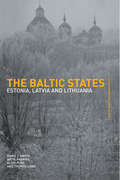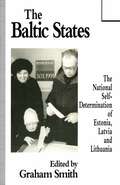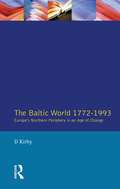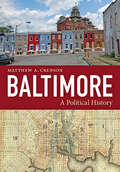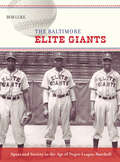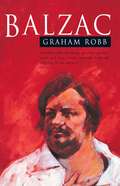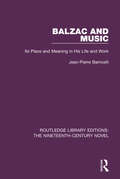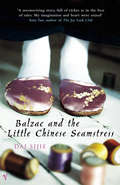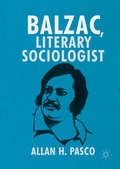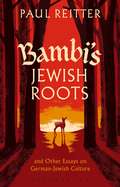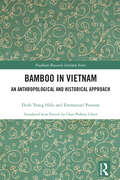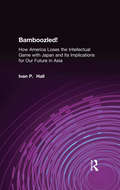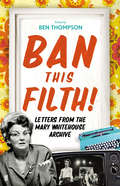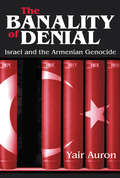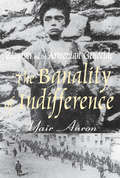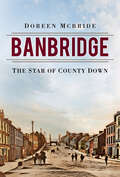- Table View
- List View
The Baltic States: Estonia, Latvia and Lithuania (Postcommunist States and Nations)
by Thomas Lane Artis Pabriks Aldis Purs David J. SmithSince the end of the Cold War there has been an increased interest in the Baltics. The Baltic States brings together three titles, Estonia, Latvia and Lithuania, to provide a comprehensive and analytical guide integrating history, political science, economic development and contemporary events into one account. Since gaining their independence, each country has developed at its own pace with its own agenda and facing its own obstacles. The authors examine the tensions accompanying a post-communist return to Europe after the long years of separation and how each country has responded to the demands of becoming a modern European state. Estonia was the first of the former Soviet republics to enter membership negotiations with the European Union in 1988 and is a potential candidate for the next round of EU expansion in 2004. Lithuania and Latvia have also expressed their desire for future membership of NATO and the EU.
The Baltic States: The National Self-Determination of Estonia, Latvia and Lithuania
by Graham SmithThe Baltic States examines the struggles of the Baltic peoples for national self-determination. It is divided into two parts. Part one explores their nationalist awakening, how the realization of national self-determination during the inter-war years of independent statehood manifested itself, and the impact that fifty years of subsequent incorporation into the Soviet Union has had on Baltic politics and national cultures. Part two examines the nationalist reawakening in the late 1980s, the re-establishment of Baltic national self-governance in 1990-91 and the problems that these countries now face as sovereign entities.
The Baltic World 1772-1993: Europe's Northern Periphery in an Age of Change
by David KirbyThis eagerly-awaited sequel shares the characteristics of its distinguished predecessor -- wide geographical and chronological span; expert mingling of political, social and economic history; and Dr Kirby's ability to keep the separate national threads of his account from tangling as he weaves them into the broad regional picture that is his main concern. Here he tackles the contrasting experiences of Europe's northern periphery -- affluence and democracy in the north, stagnation and authoritarianism in the south -- from the French Revolution to the collapse of the USSR and beyond. This is a masterly study of a region that is far from peripheral politically to the post-Soviet world.
The Baltic World 1772-1993: Europe's Northern Periphery in an Age of Change
by David KirbyThis eagerly-awaited sequel shares the characteristics of its distinguished predecessor -- wide geographical and chronological span; expert mingling of political, social and economic history; and Dr Kirby's ability to keep the separate national threads of his account from tangling as he weaves them into the broad regional picture that is his main concern. Here he tackles the contrasting experiences of Europe's northern periphery -- affluence and democracy in the north, stagnation and authoritarianism in the south -- from the French Revolution to the collapse of the USSR and beyond. This is a masterly study of a region that is far from peripheral politically to the post-Soviet world.
Baltimore: A Political History
by Matthew A. CrensonCharm City or Mobtown? People from Baltimore glory in its eccentric charm, small-town character, and North-cum-South culture. But for much of the nineteenth century, violence and disorder plagued the city. More recently, the 2015 death of Freddie Gray in police custody has prompted Baltimoreans;¢;‚¬;€?and the entire nation;¢;‚¬;€?to focus critically on the rich and tangled narrative of black;€“white relations in Baltimore, where slavery once existed alongside the largest community of free blacks in the United States.Matthew A. Crenson, a distinguished political scientist and Baltimore native, examines the role of politics and race throughout Baltimore's history. From its founding in 1729 up through the recent past, Crenson follows Baltimore's political evolution from an empty expanse of marsh and hills to a complicated city with distinct ways of doing business. Revealing how residents at large engage (and disengage) with one another across an expansive agenda of issues and conflicts, Crenson shows how politics helped form this complex city's personality.Crenson provocatively argues that Baltimore's many quirks are likely symptoms of urban underdevelopment. The city's longtime domination by the general assembly;¢;‚¬;€?and the corresponding weakness of its municipal authority;¢;‚¬;€?forced residents to adopt the private and extra-governmental institutions that shaped early Baltimore. On the one hand, Baltimore was resolutely parochial, split by curious political quarrels over issues as minor as loose pigs. On the other, it was keenly attuned to national politics: during the Revolution, for instance, Baltimoreans were known for their comparative radicalism. Crenson describes how, as Baltimore and the nation grew, whites competed with blacks, slave and free, for menial and low-skill work. He also explores how the urban elite thrived by avoiding, wherever possible, questions of slavery versus freedom;¢;‚¬;€?just as wealthier Baltimoreans, long after the Civil War and emancipation, preferred to sidestep racial controversy. Peering into the city's 300-odd neighborhoods, this fascinating account holds up a mirror to Baltimore, asking whites in particular to reexamine the past and accept due responsibility for future racial progress.
Baltimore: A Political History
by Matthew A. CrensonCharm City or Mobtown? People from Baltimore glory in its eccentric charm, small-town character, and North-cum-South culture. But for much of the nineteenth century, violence and disorder plagued the city. More recently, the 2015 death of Freddie Gray in police custody has prompted Baltimoreans;¢;‚¬;€?and the entire nation;¢;‚¬;€?to focus critically on the rich and tangled narrative of black;€“white relations in Baltimore, where slavery once existed alongside the largest community of free blacks in the United States.Matthew A. Crenson, a distinguished political scientist and Baltimore native, examines the role of politics and race throughout Baltimore's history. From its founding in 1729 up through the recent past, Crenson follows Baltimore's political evolution from an empty expanse of marsh and hills to a complicated city with distinct ways of doing business. Revealing how residents at large engage (and disengage) with one another across an expansive agenda of issues and conflicts, Crenson shows how politics helped form this complex city's personality.Crenson provocatively argues that Baltimore's many quirks are likely symptoms of urban underdevelopment. The city's longtime domination by the general assembly;¢;‚¬;€?and the corresponding weakness of its municipal authority;¢;‚¬;€?forced residents to adopt the private and extra-governmental institutions that shaped early Baltimore. On the one hand, Baltimore was resolutely parochial, split by curious political quarrels over issues as minor as loose pigs. On the other, it was keenly attuned to national politics: during the Revolution, for instance, Baltimoreans were known for their comparative radicalism. Crenson describes how, as Baltimore and the nation grew, whites competed with blacks, slave and free, for menial and low-skill work. He also explores how the urban elite thrived by avoiding, wherever possible, questions of slavery versus freedom;¢;‚¬;€?just as wealthier Baltimoreans, long after the Civil War and emancipation, preferred to sidestep racial controversy. Peering into the city's 300-odd neighborhoods, this fascinating account holds up a mirror to Baltimore, asking whites in particular to reexamine the past and accept due responsibility for future racial progress.
The Baltimore Elite Giants: Sport and Society in the Age of Negro League Baseball
by Bob LukeOne of the best-known teams in the old Negro Leagues, the Elite Giants of Baltimore featured some of the outstanding African American players of the day. Sociologist and baseball writer Bob Luke narrates the untold story of the team and its interaction with the city and its people during the long years of segregation.To convey a sense of the action on the field and the major events in the team’s history, Luke highlights important games, relives the standout performances of individual players, and discusses key decisions made by management. He introduces the team’s eventual major league stars: Roy Campanella, who went on to a ten-year Hall of Fame career with the Brooklyn Dodgers; Joe Black, the first African American pitcher to win a World Series game; and James "Junior" Gilliam, a player and coach with the Dodgers for twenty-five years. Luke also describes the often contentious relationship between the team and major league baseball before, during, and after the integration of the major leagues.The Elite Giants did more than provide entertainment for Baltimore’s black residents; the team and its star players broke the color barrier in the major leagues, giving hope to an African American community still oppressed by Jim Crow. In recounting the history of the Elite Giants, Luke reveals how the team, its personalities, and its fans raised public awareness of the larger issues faced by blacks in segregation-era Baltimore. Based on interviews with former players and Baltimore residents, articles from the black press of the time, and archival documents, and illustrated with previously unpublished photographs, The Baltimore Elite Giants recounts a barrier-breaking team’s successes, failures, and eventual demise.
Balzac
by Graham RobbGraham Robb has produced a masterpiece literary biography in which Balzac bursts into life on every page. The living manifestation of the colourful and varied world he described, yet at the same time its most astonishing exception, Balzac is the perfect subject for biography. Robb skilfully interweaves the life with the work to paint an indelible and brilliantly compelling portrait of one of the great tragicomic heroes of the nineteenth century, a man whose influence both in and outside his native France has been and is still immense.
Balzac and Music: Its Place and Meaning in His Life and Work (Routledge Library Editions: The Nineteenth-Century Novel)
by Jean-Pierre BarricelliFirst published in 1990, this book was the first comprehensive study of Balzac’s relationship to music, blending past scholarship with new perspectives to formulate an inclusive account. It begins by examining the contacts and experiences that shaped the musical side of Balzac’s life. These left valuable and lasting impressions which often found their way into his writings, where he recorded a myriad of critical and musicological opinions — assessed primarily in relation to Gambara and Massimilla Doni. These discussions prepare the way for an analysis of Balzac two major musical persuasions: religious music and Beethoven. This book will be of interest to students of literature and music.
Balzac and Music: Its Place and Meaning in His Life and Work (Routledge Library Editions: The Nineteenth-Century Novel)
by Jean-Pierre BarricelliFirst published in 1990, this book was the first comprehensive study of Balzac’s relationship to music, blending past scholarship with new perspectives to formulate an inclusive account. It begins by examining the contacts and experiences that shaped the musical side of Balzac’s life. These left valuable and lasting impressions which often found their way into his writings, where he recorded a myriad of critical and musicological opinions — assessed primarily in relation to Gambara and Massimilla Doni. These discussions prepare the way for an analysis of Balzac two major musical persuasions: religious music and Beethoven. This book will be of interest to students of literature and music.
Balzac and the Little Chinese Seamstress
by Dai Sijie1971: Mao's cultural Revolution is at its peak. Two sons of doctors, sent to 're-education' camps, forced to carry buckets of excrement up and down mountain paths, have only their sense of humour to keep them going. Although the attractive daughter of the local tailor also helps to distract them from the task at hand. The boys' true re-education starts, however, when they discover a hidden suitcase packed with the great Western novels of the nineteenth century. Their lives are transformed. And not only their lives: after listening to the stories of Balzac, the little seamstress will never be the same again.
Balzac, Literary Sociologist
by Allan H. PascoMelding the fields of literature, sociology, and history, this book develops analyses of the ten novels in Balzac's Scènes de la vie de province. Following the order of the novels projected in La Comédie humaine, Allan H. Pasco investigates how Balzac used art as a tool of social inquiry to obtain startlingly accurate insights into the relationships that defined his turbulent society. His repeated claim to be an "historian of manners" was more than an empty boast. Though Balzac was first and foremost a great novelist, he was also a trailblazing sociologist, joining Henri de Saint-Simon and the subsequent Auguste Comte in considering the relationships that represent society as an interacting, interlocking web. Using a methodology that combines close analysis with a broad cultural context, Pasco demonstrates that Balzac's sociological vision was extraordinarily pertinent to both his and our days.
Bambi's Jewish Roots and Other Essays on German-Jewish Culture
by Paul ReitterPaul Reitter has won acclaim as both a scholar and a public critic for his writing on German Jewish culture in the twentieth century. Bambi's Jewish Roots brings together the best of Reitter's essayistic work, exploring the lives of well-known figures and revealing surprising new perspectives. These include how Felix Salten's Zionist commitments manifest themselves in his most famous work, the novel Bambi; what Gershom Scholem's diaries tell us about his development as a thinker and person; why German-Jewish writers hated Stefan Zweig so passionately; where myth-busting books about Franz Kafka have indulged in myth-building; how Freud's Moses and Monotheism offers a theory of Jewish self-hatred more than an explanation of anti-Semitism; and why Heinrich Heine felt aburning need to distance himself from his fellow liberal Jewish critic Ludwig Börne.The works collected here, many of which were originally published in forums such as the New York Review of Books, London Review of Books, the Times Literary Supplement, The Nation, Harper's Magazine, and the Jewish Review of Books, have earned Reitter his reputation as a witty, erudite, and deeply illuminating critic.
Bambi's Jewish Roots and Other Essays on German-Jewish Culture
by Paul ReitterPaul Reitter has won acclaim as both a scholar and a public critic for his writing on German Jewish culture in the twentieth century. Bambi's Jewish Roots brings together the best of Reitter's essayistic work, exploring the lives of well-known figures and revealing surprising new perspectives. These include how Felix Salten's Zionist commitments manifest themselves in his most famous work, the novel Bambi; what Gershom Scholem's diaries tell us about his development as a thinker and person; why German-Jewish writers hated Stefan Zweig so passionately; where myth-busting books about Franz Kafka have indulged in myth-building; how Freud's Moses and Monotheism offers a theory of Jewish self-hatred more than an explanation of anti-Semitism; and why Heinrich Heine felt aburning need to distance himself from his fellow liberal Jewish critic Ludwig Börne.The works collected here, many of which were originally published in forums such as the New York Review of Books, London Review of Books, the Times Literary Supplement, The Nation, Harper's Magazine, and the Jewish Review of Books, have earned Reitter his reputation as a witty, erudite, and deeply illuminating critic.
Bamboo in Vietnam: An Anthropological and Historical Approach (Needham Research Institute Series)
by Đinh Trọng Hiếu Emmanuel PoissonThis book presents interdisciplinary research on bamboo in Vietnam, drawing on the anthropology of gesture, ethnobotany and the history of technology. The authors have adopted a technological approach which reviews how the terminology of different parts of the bamboo plant in the dictionaries in Romanized Vietnamese or in Vietnamese vernacular writing (nôm) enabled the authors to identify not only the plant but also each technical gesture for its appropriation by the artisan. Lithographic, literary and historical sources from the chronicles have been mobilized to illustrate the many uses of this versatile plant. Richly illustrated throughout, this book will appeal to students and scholars of Vietnam, anthropology, the history of science and technology, environmental history and architecture. It will also be of great value to those interested in the applications of bamboo in the contemporary world.
Bamboo in Vietnam: An Anthropological and Historical Approach (Needham Research Institute Series)
by Đinh Trọng Hiếu Emmanuel PoissonThis book presents interdisciplinary research on bamboo in Vietnam, drawing on the anthropology of gesture, ethnobotany and the history of technology. The authors have adopted a technological approach which reviews how the terminology of different parts of the bamboo plant in the dictionaries in Romanized Vietnamese or in Vietnamese vernacular writing (nôm) enabled the authors to identify not only the plant but also each technical gesture for its appropriation by the artisan. Lithographic, literary and historical sources from the chronicles have been mobilized to illustrate the many uses of this versatile plant. Richly illustrated throughout, this book will appeal to students and scholars of Vietnam, anthropology, the history of science and technology, environmental history and architecture. It will also be of great value to those interested in the applications of bamboo in the contemporary world.
Bamboozled!: How America Loses the Intellectual Game with Japan and Its Implications for Our Future in Asia
by Ivan P. HallAs the influence of the United States in Asia declines with the end of the Cold War, America must look more to brains than military might in achieving our objectives in the region. But after repeatedly allowing Japan - our closest ally in Asia - to mislead us intellectually and psychologically, how well are we prepared to deal with less friendly emerging powers like China and India? Based on three decades of on-the-spot observation and participation in Japan, Ivan Hall's provocative work draws the reader into a world of intellectual manipulation and gullibility, false images, emotional blackmail, financial beguilement, and fatuous expectations. It illuminates the many ways that American ideological hubris and Japanese pleading for special treatment combine to deprive our trans-Pacific dialogue of the honesty, openness, and plain common sense of our trans-Atlantic intellectual ties with Europe.
Bamboozled!: How America Loses the Intellectual Game with Japan and Its Implications for Our Future in Asia
by Ivan P. HallAs the influence of the United States in Asia declines with the end of the Cold War, America must look more to brains than military might in achieving our objectives in the region. But after repeatedly allowing Japan - our closest ally in Asia - to mislead us intellectually and psychologically, how well are we prepared to deal with less friendly emerging powers like China and India? Based on three decades of on-the-spot observation and participation in Japan, Ivan Hall's provocative work draws the reader into a world of intellectual manipulation and gullibility, false images, emotional blackmail, financial beguilement, and fatuous expectations. It illuminates the many ways that American ideological hubris and Japanese pleading for special treatment combine to deprive our trans-Pacific dialogue of the honesty, openness, and plain common sense of our trans-Atlantic intellectual ties with Europe.
Ban This Filth!: Letters From the Mary Whitehouse Archive
by Ben ThompsonIn 1964, Mary Whitehouse launched a campaign to fight what she called the 'propaganda of disbelief, doubt and dirt' being poured into homes through the nation's radio and television sets. Whitehouse, senior mistress at a Shropshire secondary school, became the unlikely figurehead of a mass movement for censorship: the National Viewers' and Listeners' Association, now Mediawatch-uk.For almost forty years, she kept up the fight against the programme makers, politicians, pop stars and playwrights who she felt were dragging British culture into a sewer of blasphemy and obscenity. From Doctor Who ('Teatime brutality for tots') to Dennis Potter (whose mother sued her for libel and won) to the Beatles - whose Magical Mystery Tour escaped her intervention by the skin of its psychedelic teeth - the list of Mary Whitehouse's targets will read to some like a nostalgic roll of honour.Caricatured while she lived as a figure of middle-brow reaction, Mary Whitehouse was held in contempt by the country's intellectual elite. But were some of the dangers she warned of more real than they imagined? Ben Thompson's selection of material from her extraordinary archive shows Mary Whitehouse's legacy in a startling new light. From her exquisitely testy exchanges with successive BBC Directors General, to the anguished screeds penned by her television and radio vigilantes, these letters reveal a complex and combative individual, whose anxieties about culture and morality are often eerily relevant to the age of the internet. 'A fantastic read . . . I can't recommend it highly enough.' Lauren Laverne, BBC Radio 6 Music
The Banality of Denial: Israel and the Armenian Genocide
by Julian SimonThe Banality of Denial examines the attitudes of the State of Israel and its leading institutions toward the Armenian Genocide. Israel's view of this issue has special significance and deserves an attentive study, as it is a country composed of a people who were victims of the Holocaust. The Banality of Denial seeks both to examine the passive, indifferent Israeli attitude towards the Armenian Genocide, and to explore active Israeli measures to undermine attempts at safeguarding the memory of the Armenian victims of the Turkish persecution.Such an inquiry into attempts at denial by Israeli institutions and leading figures of Israel's political, security, academic, and Holocaust "memory-preservation" elite has not merely an academic significance. It has considerable political relevance, both symbolic and tangible.In The Banality of Denial--as in Auron's previous work--moral, philosophical, and theoretical questions are of paramount importance. Because no previous studies have dealt with these issues or similar ones, an original methodology is employed to analyze the subject with regard to four domains: political, educational, media, and academic.
The Banality of Denial: Israel and the Armenian Genocide
by Julian SimonThe Banality of Denial examines the attitudes of the State of Israel and its leading institutions toward the Armenian Genocide. Israel's view of this issue has special significance and deserves an attentive study, as it is a country composed of a people who were victims of the Holocaust. The Banality of Denial seeks both to examine the passive, indifferent Israeli attitude towards the Armenian Genocide, and to explore active Israeli measures to undermine attempts at safeguarding the memory of the Armenian victims of the Turkish persecution.Such an inquiry into attempts at denial by Israeli institutions and leading figures of Israel's political, security, academic, and Holocaust "memory-preservation" elite has not merely an academic significance. It has considerable political relevance, both symbolic and tangible.In The Banality of Denial--as in Auron's previous work--moral, philosophical, and theoretical questions are of paramount importance. Because no previous studies have dealt with these issues or similar ones, an original methodology is employed to analyze the subject with regard to four domains: political, educational, media, and academic.
The Banality of Indifference: Zionism and the Armenian Genocide
by Yair AuronThe genocide of Armenians by Turks during the First World War was one of the most horrendous deeds of modern times and a precursor of the genocidal acts that have marked the rest of the twentieth century. Despite the worldwide attention the atrocities received at the time, the massacre has not remained a part of the world's historical consciousness. The parallels between the Jewish and Armenian situations and the reactions of the Jewish community in Palestine (the Yishuv) to the Armenian genocide, which was muted and largely self-interested, are explored by Yair Auron. In attempting to assess and interpret these disparate reactions, Auron maintains a fairminded balance in assessing claims of altruism and self-interest, expressed in universal, not merely Jewish, terms.While not denying the uniqueness of the Holocaust, Auron carefully distinguishes it from the Armenian genocide reviewing existing theories and relating Armenian and Jewish experience to ongoing issues of politics and identity. As a groundbreaking work of comparative history, this volume will be read by Armenian area specialists, historians of Zionism and Israel, and students of genocide. Yair Auron is senior lecturer at The Open University of Israel and the Kibbutzim College of Education. He is the author, in Hebrew, of Jewish-Israeli Identity, Sensitivity to World Suffering: Genocide in the Twentieth Century, We Are All German Jews, and Jewish Radicals in France during the Sixties and Seventies (published in French as well)
The Banality of Indifference: Zionism and the Armenian Genocide
by Yair AuronThe genocide of Armenians by Turks during the First World War was one of the most horrendous deeds of modern times and a precursor of the genocidal acts that have marked the rest of the twentieth century. Despite the worldwide attention the atrocities received at the time, the massacre has not remained a part of the world's historical consciousness. The parallels between the Jewish and Armenian situations and the reactions of the Jewish community in Palestine (the Yishuv) to the Armenian genocide, which was muted and largely self-interested, are explored by Yair Auron. In attempting to assess and interpret these disparate reactions, Auron maintains a fairminded balance in assessing claims of altruism and self-interest, expressed in universal, not merely Jewish, terms.While not denying the uniqueness of the Holocaust, Auron carefully distinguishes it from the Armenian genocide reviewing existing theories and relating Armenian and Jewish experience to ongoing issues of politics and identity. As a groundbreaking work of comparative history, this volume will be read by Armenian area specialists, historians of Zionism and Israel, and students of genocide. Yair Auron is senior lecturer at The Open University of Israel and the Kibbutzim College of Education. He is the author, in Hebrew, of Jewish-Israeli Identity, Sensitivity to World Suffering: Genocide in the Twentieth Century, We Are All German Jews, and Jewish Radicals in France during the Sixties and Seventies (published in French as well)
Bananas: How the United Fruit Company Shaped the World
by Peter ChapmanIn this compelling history, Peter Chapman shows how the United Fruit Company took bananas from the jungles of Costa Rica to the halls of power in Washington, D.C., with not just clever marketing, but covert CIA operations, bloody coups and brutalised workforces. And how along the way they turned the banana into a blueprint for a new model of unfettered global capitalism: one that serves corporate power at any cost.
Banbridge: The Star of County Down
by Doreen McBrideBanbridge gets its name from the bridge built across the River Bann in 1712. It’s a thriving modern town, rife with history and culture, surrounded by beautiful scenery that provided an iconic location for the internationally acclaimed television series Game of Thrones. It’s the setting of the well-known folk song ‘The Star of the County Down’, contains Europe's first flyover bridge and an ancient church founded by St Patrick himself. Travel from Ballievey along the Lower Bann, discover ancient Celtic sites, the remains of old linen mills and a Second World War aeroplane factory. Look, too, for the famous names attached to Banbridge, including Ernest Walton, the first person to see an artificially split atom; F.E. McWilliam, the renowned sculptor; and Captain Francis Crozier, the explorer who discovered the North West Passage.
